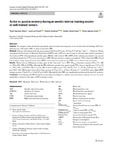Active vs. Passive Recovery During an Aerobic Interval Training Session in Well-Trained Runners

Use este enlace para citar
http://hdl.handle.net/2183/30755
A non ser que se indique outra cousa, a licenza do ítem descríbese como Atribución 4.0 Internacional
Coleccións
- Investigación (CCDEF) [297]
Metadatos
Mostrar o rexistro completo do ítemTítulo
Active vs. Passive Recovery During an Aerobic Interval Training Session in Well-Trained RunnersAutor(es)
Data
2022-03-09Cita bibliográfica
Tania Sánchez Otero, José Luis Tuimil, Daniel Boullosa, Adrián Varela Sanz, Eliseo Iglesias Soler. European Journal of Applied Physiology (2022) 122:1281–1291 https://doi.org/10.1007/s00421-022-04926-2
Resumo
[Abstract] Purpose To compare cardio-metabolic, perceptual and neuromuscular responses to an aerobic interval training (AIT) running session, with active (AR) vs. passive recovery (PR). Methods Eleven well-trained male distance runners (36.63±6.93 years, 59.26±5.27 mL·kg−1·min−1, ⁓ 35 min in 10 km) completed the University of Montréal Track Test (UMTT) and 2 AIT sessions on track in random order, which consisted of 4×2 min at 100% of the maximum aerobic speed (MAS), with 2 min of AR at 80% of the velocity associated to the second ventilatory threshold (vVT2), or no exercise (i.e., PR). During sessions, oxygen consumption (V̇O2), heart rate (HR), blood lactate [La], rating of perceived exertion (RPE), and countermovement jump (CMJ) were continuously monitored. Results There were no diferences in time spent in the “red zone” (i.e.>90% V̇O2max) between sessions (222±73 s AR vs. 230±104 s PR, p=0.588), although the PR exhibited a greater time spent at peak V̇O2 close to signifcance (117±114 vs. 158±109 s, p=0.056). However, the AR elicited a higher mean V̇O2 (49.62±5.91 vs. 47.46±4.20 mL·kg−1·min−1, p=0.021). The AR favored a lower [La] after sessions (6.93±2.22 vs. 6.24±1.93 mmol·L−1, p=0.016) and a higher RPE during sessions (15±0.45 vs. 14±0.47, p=0.045). Meanwhile, the CMJ was signifcantly potentiated during both sessions. Conclusion Considering that PR elicited lower perceptual loading for a similar cardiorespiratory response, its use would be preferable, at least, for this type of AIT running sessions.
Palabras chave
HIIT
Running
Red zone
Work interval
Rest interval
Correr
Zona vermella
Intervalo de traballo
Intervalo de descanso
Zona roja
Intervalo de trabajo
Running
Red zone
Work interval
Rest interval
Correr
Zona vermella
Intervalo de traballo
Intervalo de descanso
Zona roja
Intervalo de trabajo
Descrición
Financiado para publicación en acceso aberto: Universidade da Coruña/CISUG
Versión do editor
Dereitos
Atribución 4.0 Internacional
ISSN
1439-6327






